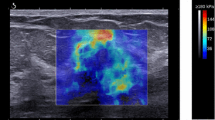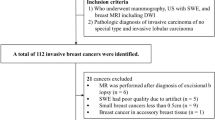Abstract
Objective
To assess stiffness in a human breast cancer implanted in mice using shear wave elastography (SWE) during tumour growth and to correlate the results with pathology.
Methods
Local ethics committee for animal research approval was obtained. A human invasive ductal carcinoma was implanted subcutaneously in 24 athymic nude female mice. Ultrasound was longitudinally performed in 22 tumours, every 1–2 weeks. Maximum diameter and mean stiffness were collected. Seven tumours were measured both in vivo and ex vivo. Tumours of different sizes were removed for pathological analysis on which the percentages of viable cellular tissue, fibrosis and necrosis were measured.
Results
A total of 63 SWE measurements were performed. Stiffness increased during tumour growth with an excellent correlation with size (r = 0.94, P < 0.0001). No differences were found between the values of stiffness in vivo and ex vivo (P = 0.81). There was a significant correlation between elasticity and fibrosis (r = 0.83, P < 0.0001), a negative correlation with necrosis (r = −0.76, p = 0.0004) but no significant correlation with cellular tissue (r = 0.40, p = 0.1).
Conclusion
Fibrosis plays an important role in stiffness as measured by SWE, whereas necrosis is correlated with softness.
Key Points
• In a breast cancer model, ultrasound tumour stiffness is correlated with size.
• Stiffness changes with tumour growth are correlated with pathological changes.
• Stiffness is very well correlated with proportion of tumour fibrosis.
• Stiffness is inversely correlated with proportion of tumour necrosis.
• Tumour stiffness measurements are similar in vivo and ex vivo.





Similar content being viewed by others
References
Jemal A, Bray F, Center MM, Ferlay J, Ward E, Forman D (2011) Global cancer statistics. CA Cancer J Clin 61:69–90
Abdullah N, Mesurolle B, El-Khoury M, Kao E (2009) Breast imaging reporting and data system lexicon for US: interobserver agreement for assessment of breast masses. Radiology 252:665–672
Homer MJ (1987) Imaging features and management of characteristically benign and probably benign breast lesions. Radiol Clin North Am 25:939–951
Hall FM (2002) Negative predictive value of breast imaging in patients with palpable lesions. AJR Am J Roentgenol 179:1073, author reply 1073–1074
Rosen EL, Baker JA, Soo MS (2002) Malignant lesions initially subjected to short-term mammographic follow-up. Radiology 223:221–228
Athanasiou A, Tardivon A, Tanter M et al (2010) Breast lesions: quantitative elastography with supersonic shear imaging–preliminary results. Radiology 256:297–303
Cho N, Moon WK, Chang JM et al (2011) Sonoelastographic lesion stiffness: preoperative predictor of the presence of an invasive focus in nonpalpable DCIS diagnosed at US-guided needle biopsy. Eur Radiol 21:1618–1627
Lee JH, Kim SH, Kang BJ et al (2011) Role and clinical usefulness of elastography in small breast masses. Acad Radiol 18:74–80
Itoh A, Ueno E, Tohno E et al (2006) Breast disease: clinical application of US elastography for diagnosis. Radiology 239:341–350
Yi A, Cho N, Chang JM, Koo HR, La Yun B, Moon WK (2012) Sonoelastography for 1,786 non-palpable breast masses: diagnostic value in the decision to biopsy. Eur Radiol 22:1033–1040
Berg WA, Cosgrove DO, Dore CJ et al (2012) Shear-wave elastography improves the specificity of breast US: the BE1 multinational study of 939 masses. Radiology 262:435–449
Chang JM, Moon WK, Cho N et al (2011) Clinical application of shear wave elastography (SWE) in the diagnosis of benign and malignant breast diseases. Breast Cancer Res Treat 129:89–97
Evans A, Whelehan P, Thomson K et al (2012) Invasive breast cancer: relationship between shear-wave elastographic findings and histologic prognostic factors. Radiology 263:673–677
Marangoni E, Vincent-Salomon A, Auger N et al (2007) A new model of patient tumor-derived breast cancer xenografts for preclinical assays. Clin Cancer Res 13:3989–3998
Nitta Y, Kawabe N, Hashimoto S et al (2009) Liver stiffness measured by transient elastography correlates with fibrosis area in liver biopsy in patients with chronic hepatitis C. Hepatol Res 39:675–684
Bavu E, Gennisson JL, Couade M et al (2011) Noninvasive in vivo liver fibrosis evaluation using supersonic shear imaging: a clinical study on 113 hepatitis C virus patients. Ultrasound Med Biol 37:1361–1373
Mueller S, Millonig G, Sarovska L et al (2010) Increased liver stiffness in alcoholic liver disease: differentiating fibrosis from steatohepatitis. World J Gastroenterol 16:966–972
Palmeri ML, Wang MH, Rouze NC et al (2011) Noninvasive evaluation of hepatic fibrosis using acoustic radiation force-based shear stiffness in patients with nonalcoholic fatty liver disease. J Hepatol 55:666–672
Ziol M, Kettaneh A, Ganne-Carrie N, Barget N, Tengher-Barna I, Beaugrand M (2009) Relationships between fibrosis amounts assessed by morphometry and liver stiffness measurements in chronic hepatitis or steatohepatitis. Eur J Gastroenterol Hepatol 21:1261–1268
Wojcinski S, Farrokh A, Weber S et al (2010) Multicenter study of ultrasound real-time tissue elastography in 779 cases for the assessment of breast lesions: improved diagnostic performance by combining the BI-RADS®-US classification system with sonoelastography. Ultraschall Med 31:484–491
Leong LC, Sim LS, Lee YS et al (2010) A prospective study to compare the diagnostic performance of breast elastography versus conventional breast ultrasound. Clin Radiol 65:887–894
Cho N, Jang M, Lyou CY, Park JS, Choi HY, Moon WK (2012) Distinguishing benign from malignant masses at Breast US: combined US elastography and color Doppler US–influence on radiologist accuracy. Radiology 262:80–90
Ophir J, Cespedes I, Ponnekanti H, Yazdi Y, Li X (1991) Elastography: a quantitative method for imaging the elasticity of biological tissues. Ultrason Imaging 13:111–134
Sandrin L, Catheline S, Tanter M, Hennequin X, Fink M (1999) Time-resolved pulsed elastography with ultrafast ultrasonic imaging. Ultrason Imaging 21:259–272
Sandrin L, Tanter M, Catheline S, Fink M (2002) Shear modulus imaging with 2-D transient elastography. IEEE Trans Ultrason Ferroelectr Freq Control 49:426–435
Wang Y, Orescanin M, Insana MF (2010) In vivo measurement of the complex shear modulus of rat mammary tumors using shear wave imaging techniques. Conf Proc IEEE Eng Med Biol Soc 2010:29–32
Wang MH, Palmeri ML, Guy CD et al (2009) In vivo quantification of liver stiffness in a rat model of hepatic fibrosis with acoustic radiation force. Ultrasound Med Biol 35:1709–1721
Evans A, Whelehan P, Thomson K et al (2010) Quantitative shear wave ultrasound elastography: initial experience in solid breast masses. Breast Cancer Res 12:R104
Cosgrove DO, Berg WA, Dore CJ et al (2011) Shear wave elastography for breast masses is highly reproducible. Eur Radiol 2:1023–1032
Chang JM, Moon WK, Cho N, Kim SJ (2011) Breast mass evaluation: factors influencing the quality of US elastography. Radiology 259:59–64
Yu L, Yang W, Cai X, Shi D, Fan Y, Lu H (2010) Centrally necrotizing carcinoma of the breast: clinicopathological analysis of 33 cases indicating its basal-like phenotype and poor prognosis. Histopathology 57:193–201
Acknowledgments
J.L. Gennisson is a consultant for SupersonicImagine. M. Tanter received royalties and holds stock options in SupersonicImagine. F. Chamming’s received grants from Société Française de Radiologie.
Author information
Authors and Affiliations
Corresponding author
Rights and permissions
About this article
Cite this article
Chamming’s, F., Latorre-Ossa, H., Le Frère-Belda, M.A. et al. Shear wave elastography of tumour growth in a human breast cancer model with pathological correlation. Eur Radiol 23, 2079–2086 (2013). https://doi.org/10.1007/s00330-013-2828-8
Received:
Revised:
Accepted:
Published:
Issue Date:
DOI: https://doi.org/10.1007/s00330-013-2828-8




